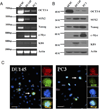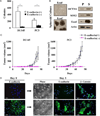Expression of pluripotent stem cell reprogramming factors by prostate tumor initiating cells
- PMID: 20303530
- PMCID: PMC4451595
- DOI: 10.1016/j.juro.2009.12.092
Expression of pluripotent stem cell reprogramming factors by prostate tumor initiating cells
Abstract
Purpose: We identified a discrete population of stem cell-like tumor cells expressing 5 essential transcription factors required to reprogram pluripotency in prostate tumor cell lines and primary prostate cancer tissue.
Materials and methods: DU145 and PC3 human prostate cancer cell lines (ATCC), tumor tissue from patients with prostate cancer and normal prostate tissue were evaluated for the reprogramming factors OCT3/4 (Cell Signaling Technology), SOX2, Klf4 (Santa Cruz Biotechnology, Santa Cruz, California), Nanog (BioLegend) and c-Myc (Cell Signaling) by semiquantitative reverse transcriptase-polymerase chain reaction, histological and immunohistochemical analysis. Stem cell-like tumor cells were enriched by flow cytometric cell sorting using E-cadherin (R&D Systems) as a surface marker, and soft agar, spheroid and tumorigenicity assays to confirm cancer stem cell-like characteristics.
Results: mRNA expression of transcription factors OCT3/4 and SOX2 highly correlated in primary prostate tumor tissue samples. The number of OCT3/4 or SOX2 expressing cells was significantly increased in prostate cancer tissue compared to that in normal prostate or benign prostate hyperplasia tissue (p <0.05). When isolated from the DU145 and PC3 prostate cancer cell lines by flow cytometry, stem cell-like tumor cells expressing high OCT3/4 and SOX2 levels showed high tumorigenicity in immunodeficient mice. In vivo growth of the parental DU145 and PC3 prostate cancer cell lines was inhibited by short hairpin RNA knockdown of OCT3/4 or SOX2.
Conclusions: Data suggest that prostate tumor cells expressing pluripotent stem cell transcription factors are highly tumorigenic. Identifying such cells and their importance in prostate cancer growth could provide opportunities for novel targeting strategies for prostate cancer therapy.
2010 American Urological Association Education and Research, Inc. Published by Elsevier Inc. All rights reserved.
Figures






Similar articles
-
Klf4 transcription factor is expressed in the cytoplasm of prostate cancer cells.Eur J Cancer. 2013 Mar;49(4):955-63. doi: 10.1016/j.ejca.2012.09.023. Epub 2012 Oct 22. Eur J Cancer. 2013. PMID: 23089465
-
Comprehensive analysis of the clinical significance of inducing pluripotent stemness-related gene expression in colorectal cancer cells.Ann Surg Oncol. 2009 Sep;16(9):2638-44. doi: 10.1245/s10434-009-0567-5. Epub 2009 Jun 25. Ann Surg Oncol. 2009. PMID: 19554373
-
A convenient and effective strategy for the enrichment of tumor-initiating cell properties in prostate cancer cells.Tumour Biol. 2016 Sep;37(9):11973-11981. doi: 10.1007/s13277-016-5046-6. Epub 2016 Apr 25. Tumour Biol. 2016. PMID: 27113741
-
Directing reprogramming to pluripotency by transcription factors.Curr Opin Genet Dev. 2012 Oct;22(5):416-22. doi: 10.1016/j.gde.2012.07.001. Epub 2012 Aug 3. Curr Opin Genet Dev. 2012. PMID: 22868173 Review.
-
The genetics of induced pluripotency.Reproduction. 2010 Jan;139(1):35-44. doi: 10.1530/REP-09-0024. Reproduction. 2010. PMID: 19605512 Review.
Cited by
-
Salinomycin induces cell death and differentiation in head and neck squamous cell carcinoma stem cells despite activation of epithelial-mesenchymal transition and Akt.BMC Cancer. 2012 Nov 24;12:556. doi: 10.1186/1471-2407-12-556. BMC Cancer. 2012. PMID: 23176396 Free PMC article.
-
JAG1 Intracellular Domain Enhances AR Expression and Signaling and Promotes Stem-like Properties in Prostate Cancer Cells.Cancers (Basel). 2022 Nov 21;14(22):5714. doi: 10.3390/cancers14225714. Cancers (Basel). 2022. PMID: 36428807 Free PMC article.
-
The crossroads between cancer stem cells and aging.BMC Cancer. 2015;15 Suppl 1(Suppl 1):S1. doi: 10.1186/1471-2407-15-S1-S1. Epub 2015 Jan 15. BMC Cancer. 2015. PMID: 25708542 Free PMC article. Review.
-
Cancer stem cell subsets and their relationships.J Transl Med. 2011 May 4;9:50. doi: 10.1186/1479-5876-9-50. J Transl Med. 2011. PMID: 21542915 Free PMC article.
-
Overexpression of SOX2 promotes migration, invasion, and epithelial-mesenchymal transition through the Wnt/β-catenin pathway in laryngeal cancer Hep-2 cells.Tumour Biol. 2014 Aug;35(8):7965-73. doi: 10.1007/s13277-014-2045-3. Epub 2014 May 16. Tumour Biol. 2014. PMID: 24833089
References
-
- Jemal A, Siegel R, Ward E, et al. Cancer statistics. CA Cancer J Clin. 2008;58:71. - PubMed
-
- Nelson WG, De Marzo AM, Isaacs WB. Prostate cancer. N Engl J Med. 2003;349:366. - PubMed
-
- Lawson DA, Xin L, Lukacs R, et al. Prostate stem cells and prostate cancer. Cold Spring Harb Symp Quant Biol. 2005;70:187. - PubMed
-
- Jordan CT, Guzman ML, Noble M. Cancer stem cells. N Engl J Med. 2006;355:1253. - PubMed
-
- Rossi DJ, Weissman IL. Pten, tumorigenesis, and stem cell self-renewal. Cell. 2006;125:229. - PubMed
Publication types
MeSH terms
Substances
Grants and funding
LinkOut - more resources
Full Text Sources
Other Literature Sources
Medical
Research Materials

